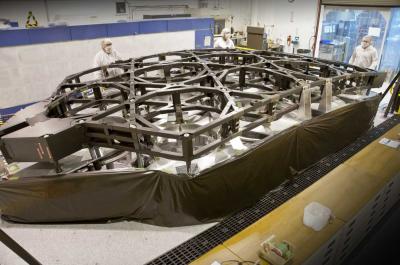As part of telescope's hardware development, the backplane structure’s center section has achieved its aviation on NASA's James Webb Space Telescope. This mission will serve as a platform, through which backplane can handle and support the telescope's thermal control systems, beryllium mirrors, other hardware and instruments.
 The center section of the James Webb Space Telescope flight backplane, or Primary Mirror Backplane Support Structure, at ATK's manufacturing facility in Magna, Utah. Credit: ATK
The center section of the James Webb Space Telescope flight backplane, or Primary Mirror Backplane Support Structure, at ATK's manufacturing facility in Magna, Utah. Credit: ATK
Webb's 18-segment, 21-foot-diameter primary mirror will be kept static by the primary mirror backplane support structure or the center section. The telescope scans into deep space. Among all the three sections of the backplane, the center section will be completed first.
The center section of the backplane weighs 500 lb and measures 24 by 12 ft. It complies with major thermal stability requirements. The backplane safely maintains the telescope's optics alignment even when subjected to rigors of launch. In addition, it also maintains operating temperatures up to– 406° F. At times of science operations, the backplane holds the 18 primary mirror segments, allowing the mirrors to line up resulting in single, pristine shape, thereby enabling the capture of deep images.
The construction of the center section was achieved through the joint operation of California-based Northrop Grumman Corporation and its teammate Utah-based ATK. Northrop Grumman has received Goddard’s contract that involves designing and constructing Webb's sunshield, spacecraft and telescope.
The powerful Webb telescope was developed following the launch of Hubble Space Telescope. It is used for observing long-distance objects in the planet. It can capture images of the first-formed primary galaxies and also used to observe planets surrounding the distant stars. The Webb telescope is a joint effort of the European Space Agency, NASA, and the Canadian Space Agency.